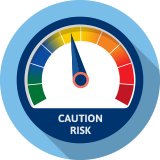August 14, 2018
L&S Risk Pulse™ Score

Caution
Long-term macroeconomic conditions are strong, but at least several core economic indicators show weakness with noteworthy but outlying risk that requires monitoring. Valuations are approaching high for a majority of stocks.
L&S Risk Pulse™ Insights – “The Few, The Proud, The Big 10″
General Comments
The S&P 500 is an index of 500 stocks that are weighted according to the market capitalization of the companies selected. This provides a biased index that tends to give the greatest importance to the very largest companies in the index. The top 10 companies of the index represent nearly 25% of the value of the index. Said another way, 2% of the stocks comprise 25% of the returns. Further, the largest company in the index, Apple, which was the first company to exceed a market capitalization of $1 trillion, is over 200 times larger than the smallest company in the index. Imagine a portfolio manager that built a portfolio for you. In that portfolio, she purchased $25,000 worth of Apple. In order to have the same weighting as the S&P 500 index, she would also own the smallest company (Brighthouse Financial, recently spun out of MetLife), but she would own only $120 worth of that company. Why bother? If Brighthouse is up 100%, a gain of $120 for your portfolio, Apple would need to be up only one-half of one-percent to provide the same $120 gain. Seems like the deck is stacked.
This is the environment we have been living with, and it has been particularly noticeable so far this calendar year. The gains in the market have been concentrated in only a very small number of stocks. We can see that in the fact that the Dow Jones Industrial Average and the equal-weighted S&P 500 (where each of the 500 stocks in the index has the same contribution to the index) have dramatically underperformed the cap-weighted and biased S&P 500.
As you may recall, we spend significant energy following different economic indicators and data points with the goal of trying to identify risks as they unfold. This too has been a difficult period as many indicators have weakened this month as compared to previous levels. It is very difficult to determine whether recent weakness is a harbinger of further weakness to come, or whether the weakness is simply summer doldrums and is temporary. We will not know the answer to that for several more months. Stay tuned.
Domestic markets have been able to shrug off threats of trade tariffs, expanding federal deficits, and political noise, and have attempted to regain the highs posted in January. The market has been driven by strong gains in corporate earnings which are up over 20% for this quarter as compared to last year. We are firm believers that earnings drive markets, and we are even more encouraged by calculations that show roughly 2/3 of earnings gains are coming from strong underlying fundamentals, with another 1/3 coming from tax cuts. We do worry that higher input costs, caused in part by tariffs, suggest that corporate profit margins may be peaking. Peaking profit margins have typically preceded market tops, and we can’t help but wonder whether this is another indicator that is simply weakening or whether it does portend further market weakness?
Conclusion
The market’s gains have been concentrated in a very small number of stocks, and narrow participation is yet another sign of a market that is struggling. Still, corporate earnings gains are strong, and the market will respond quite positively to any reduction in trade concerns. We remain focused on the potential for a changing environment. The fundaments do suggest the market has further room to run.
